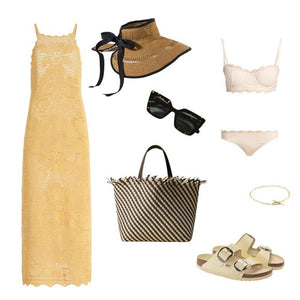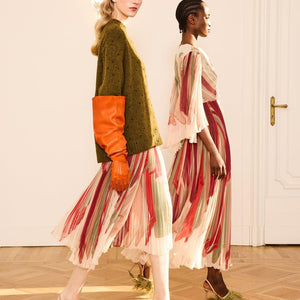
Instagram/@leolin_official
The hourglass figure — that iconic shape characterized by a nipped-in waist contrasted with curving hips and bust — has long been a symbol of feminine beauty and allure. From the tightly laced corsets of the Victorian era to the waist-celebrating designs gracing red carpets today, this timeless silhouette has captivated fashion lovers for centuries.
But the hourglass is not a singular, rigid ideal. It's a celebration of curves, an approach to dressing that highlights your unique proportions through strategic garment choices and clever styling. The hourglass is less about specific measurements and more about emphasizing that coveted visual contrast between the waist and the hips and bust.

Sofia Vergara is a brilliant example of an Hourglass body shape. Instagram/@sofiavergara
In this exploration, we'll trace the fascinating history and cultural significance of the hourglass figure. You'll learn how to identify your body's natural lines and proportions to adapt this look for your shape. We'll dive into the garment science behind different fabrics and cuts that enhance curves and share styling strategies for putting a modern spin on this classic aesthetic.
By the end, you'll be armed with the knowledge and inspiration to embrace your own interpretation of the hourglass — not as a cookie-cutter look, but as an avenue for your singular self-expression. You'll have the tools to define your waist and celebrate your silhouette with confidence for any occasion. Let's embark on this journey of sartorial discovery as we decode the enduring appeal of the hourglass.
Tracing the Hourglass Through History

Venus de Milo was considered as a golden standard of female beauty. Wiki
The female figure has long been a source of artistic and fashionable fascination, with the placement and proportion of the waist playing a central role. In the Western canon, the dramatic waist-to-hip ratio of the Venus de Milo set a classical standard for the hourglass. The 16th century saw the rise of the corset, which reached its apex in the Victorian era, when cinch-waisted looks like the 'waspie' corset created an almost anatomically impossible ideal.

The S-shape corset pictured in Ladies Home Journal, 1900
The Edwardian S-shaped silhouette shifted focus to the bust, with the waist still nipped but less severely than in the Victorian era. The 1920s brought a rebellion against restrictive corsetry, with loose silhouettes that deemphasized curves. But the hourglass roared back in the 1940s and 50s with Dior's New Look and stars like Marilyn Monroe, who once quipped, "I don't know who invented high heels, but women owe him a lot!"

Iconic new look silhouette. Vogue
Each decade offers a new interpretation of the hourglass, from the 80s peplums of Thierry Mugler to the waist-enhancing bandage dresses of Hervé Leger in the 2000s. Today, designers like Zac Posen and Michael Kors continue to deliver hourglass frocks for the red carpet and beyond. The common thread? That magnificent synergy between the natural curves of the body and the craftsmanship of garment construction.
Research also suggests an evolutionary component to the hourglass allure. Studies have shown that a waist-to-hip ratio of around 0.7 — the classic hourglass proportion — is subconsciously deemed attractive across cultures. Some scientists posit that this silhouette signifies reproductive health and fertility. The enduring appeal of the cinched waist, it seems, is built into both our aesthetic heritage and our biological hard-wiring.
Understanding Your Unique Waist and Proportions

Your waist is the narrower part of your bodice. Pictured: Teyana Taylor, Instagram/@victoriassecret
To craft your signature hourglass look, begin by mapping your unique structure. Are you short or long-waisted? Is your waist placed high or low relative to your height? Do you have a straighter figure or ample curves? Grab a tape measure and stand in front of a mirror to identify your natural shape.
Your waist is located at the narrowest part of your midsection, typically just above your belly button. But every body carries weight differently. Some women may find their waists higher or lower than this natural mid-point. There is no universal "perfect" placement — only what flatters your figure best.

Need to elongate your legs? Go for a high rise. Want to elongate the torso? Opt for a low rise. Instagram/@varley
Consider proportions in tandem with your vertical line. A high waist can gorgeously elongate the legs on petites, while a lower waist can balance statuesque figures. A long torso allows for more waist real estate to define, while a compact one may prefer a shorter span of waist emphasis.
Most importantly, release any preconceived notions of what an hourglass "should" look like. A 36-24-36 is not the definitive golden ratio. Rather, it's about identifying your personal points of balance — the yin and yang of your individual symmetry. Whether you have a delicate nipped-in silhouette or a voluptuous haute-couture curve, your natural lines are your blueprint.
Garment Science: Fabrics and Cuts for Waist Enhancement

Denim hugs the body tightly and securely comparing to satin or chiffon. Instagram/@gap
With your proportions charted, you're ready to shop your ideal silhouettes. Certain garment qualities are essential for creating that coveted whittled-waist effect. Firstly, look for structured fabric. Stiffer materials like wool, dense cotton, brocade, and taffeta naturally hold a sculpted shape and are less likely to collapse or cling at the waistline.
Seek out thoughtful tailoring designed to contour curves. Darts, princess seams and strategic panels curve in then flare out in an hourglass pattern. Defined waistbands, whether on a vintage-inspired skirt or a pair of high-rise trousers, are key. Belts are your waist-defining allies, instantly segmenting your silhouette. Peplums and basques create the illusion of hip curve, even if you carry your weight in the tummy.

These shorts have a built-in corset-darted waist that does all the shaping. Prada, Moda Operandi
Corsetry is not just the domain of Bridgerton. Many modern dresses and tops have built-in boning and structure at the waist for a subversively supportive anchor — no organ-shifting required. When you find a beautifully built garment that feels like a second skin, buy in every color. The waist-enhancing labor is woven right into the seams.
Certain garments are hourglass icons. The wrap dress is universally waist-defining, adjustable to your perfect fit. The fit-and-flare is magic for carving waistlines. Bustier tops and anything with a sweetheart or curved empire waistline will make the most of your narrowest point up top. When in doubt, channel your inner retro bombshell in an A-line midi-skirt with a tucked-in blouse. The key is zeroing in on pieces that lovingly hug and highlight your center.
Styling Strategies for Defining the Waist

Want to create an hourglass silhouette? Play with volumes and proportions. Instagram/@toni_maticevski
Even without any particular piece, you can create alluring waist definition through artful arrangement. The magic formula? Fitted on top or bottom, with opposing volume. Tuck a slinky bodysuit into a high-waisted pleated trouser. Pair a puff-sleeved blouse with a tube skirt. Belt a billowy maxi for instant shape.
Layering can be your hourglass ally. Build looks around cropped, waist-length toppers to segment your silhouette. A shrunken leather jacket, a bow-tied button-down, a sexy bustier — each will compress through the middle. Playing with lengths above and below also helps punctuate your center, like a long tunic over skinny jeans or a mini-dress over tailored trousers.

High-waisted bottoms and tucked in tops always help to define the waist. Instagram/@zara
Color and print can also trick the eye into zeroing in on your waistline. Use a contrasting belt to break up a monochrome outfit. Choose strategic colorblocking or print placement that draws a horizontal line across your middle, like a striped tee or dark-paneled sides on a light-colored dress. Visual lines will train the gaze exactly where you want it.
Don't be afraid to really go for it with your waist-emphasis of choice. Bow, knot and tuck with abandon. The 90s supermodel way to fasten a jean jacket is to criss-cross the bottom panels for a DIY shaping effect. If a garment has extra fabric at the waist, experiment with ruching or draping for added definition. Your styling imagination is your best tool for waist-centric innovation.
Adapting the Hourglass for Every Occasion

Instagram/@massimodutti
Armed with an arsenal of waist-defining separates and clever styling tricks, you're ready to translate your signature shape for every corner of your closet. For the office, structure is supreme. A sleek sheath with contoured seaming reads all business, while a belted blazer with a peplum blouse is girl-boss chic.
On the weekend, have fun with high-low mash-ups. Wide-leg jeans go from boho to bombshell with a French-tucked striped tee and a low-slung western belt. Running errands is instantly glamorous with a belted trench or an anorak nipped in over leggings.

Instagram/@carolinaherrera
For evening drama, all-over volume is your friend. A ball gown skirt with a tiny bustier bodice is the ultimate in exaggerated curves. Mermaid-shaped silhouettes are classic for showcasing a nipped waist, while the dropped-waist trend creates a modern, slouchy take on the hourglass.
The key to mastering the many moods of the hourglass is experimentation. Each body carries curves uniquely, so take time to play. Pose, move, and take note of what feels powerful and comfortable. The right waist-defining ensemble should make you feel held and celebrated in equal measure.
Embracing Your Singular Silhouette

Instagram/@cosstores
From the eternal Venus de Milo to the boundary-pushing runways of today, fashion's lovingly obsessive emphasis on the waist endures. But the hourglass is not a narrow set of measurements — it's an evolving dialogue between the natural poetry of the human form and the ever-shifting semiotics of style.

Instagram/@helsastudio
By tracing the history of the hourglass, decoding its sartorial architecture, and populating your wardrobe with waist-defining icons, you're writing your own chapter in this aesthetic saga. You now possess the tools and inspiration to honor your shape across every era, occasion and mode of self-expression.
As you venture forth to explore your version of this timeless feminine ideal, remember that your curves are wholly yours. No garment can construct them and no trend can define them. Rather, your natural lines are the sacred geometry upon which you build your own signature. Embrace your singular silhouette with the knowledge that you — and no one else — are the sculptor of your incomparable, inimitable, eternal hourglass.




